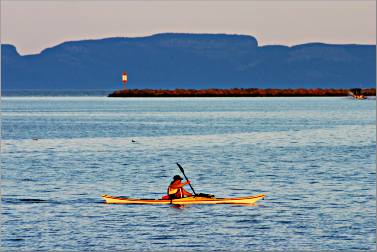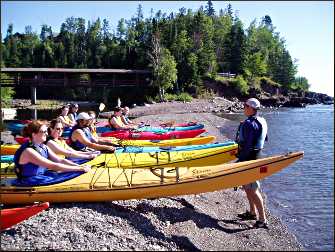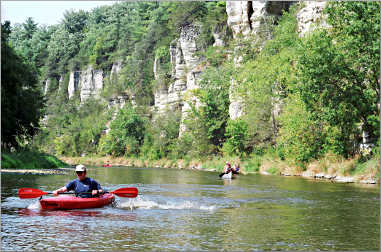Trying kayaking
Think the sport looks cool? It's easy to get your feet wet.

© Beth Gauper
For a lot of people, canoeing is last year's sport. Kayaking is a step up, like trading in the minivan for a Miata.
Who wouldn't want a zippy little kayak to pilot all by yourself, without that other person yelling at you from the stern (or bow)?
But a kayak with all the accessories is expensive. And it's hard to decide what kind of boat to buy, because you need a different kind for different bodies of water — whitewater, lakes, rivers and inland seas, such as the Great Lakes.
First, try the sport with an outfitter, nature center or state-park program.
Then, rent a boat from an outdoors store and spend a few weekends paddling on your own. If you decide you want your own boat, try out several kinds during free demo days on lakes.
After you buy your own boat, hone techniques by joining a paddle club, where more experienced paddlers will help you. Get even better by going to a paddling festival.
Here's how to get started.
Trying the sport
Many outdoors stores hold free demos on lakes throughout the summer, starting in late April. Just show up and take some boats out for a spin. The more you try, the better sense you'll get of what you want.
Then, take a low-key class from a parks district or environmental center. Many outfitters and outdoors stores also offer inexpensive day paddles.
Next, rent a boat for a weekend. It's always cheaper to rent for a weekend or week. Rates include life vests, paddles, spray skirts and vehicle pads and straps.
Universities and colleges that have outdoors programs often rent boats inexpensively, to the public as well as students.
In the Twin Cities, Midwest Mountaineering holds kayak demos all summer, many on Lake Nokomis. It sells and rents a wide variety of kayaks. It often offers a Kayaking 101 class at the Minneapolis store.

© Beth Gauper
In Madison, Rutabaga Paddlesport Shop rents kayaks and offers classes, youth and family programs, group paddles and day trips.
In Marquette and Houghton on Michigan's Upper Peninsula, Downwind Sports holds many kayak demos.
In the Driftless Area of northeast Iowa, Crawdaddy Outdoors in Waverly holds Demo Days. It rents boats for use on many good kayaking rivers — the Upper Iowa, Cedar, Shell Rock, Turkey, Volga, Wapsipinicon and Macquoketa.
In summer, it offers guided river floats.
REI stores require reservations and a fee to attend its demos; the fee is waived for people who buy a boat. The policy does allow potential buyers to request specific boats to try, and REI staff are able to work more closely with customers.
Shopping for a kayak
First, go to your local outdoors stores and talk to the sales folks. Be sure to take notes, because after a while, your head will be swimming.
Looking for the right boat is a lot like dating — you'll see a whole array of fine qualities, but never all in the same candidate.
Some kayaks are super-stable, with a sit-on-top seat or extra-big cockpits for fishing equipment, bird-watching gear or even a dog. They're also super-slow.
Some kayaks are very fast, but slim and tippy. Most people think they want a sea kayak, the long, sleek boats that slice through the water. The longer the boat, the better it will track in the water, and the less energy you'll expend to propel it.
However, the longer the boat is, the more it weighs — unless you can afford $3,000 for a fiberglass-Kevlar composite — and that means you'll expend more energy hoisting it onto and off a vehicle and into the water.
"For people paddling in the cities, (a sea kayak) is more boat than you really need or usually want," says kayaker Peter Orton, who sells sea kayaks for Valley. "The buying public really likes stability; they don't really have aspirations for high performance. You can have an awesome time in a little rec boat that costs $300."

© Beth Gauper
You wouldn't want to take a 17-foot sea kayak onto a small, winding river, because they're too long to turn easily, and you may crack it on a boulder. But they're fine on lakes.
A 10-foot boat will turn easily, but it also will zig and zag on a lake no matter how well you paddle.
A 13-foot hybrid can handle both Class II rapids on a river and a calm day along the Lake Superior shore. But it won't handle waves nearly as well as a sea kayak. And if all your friends are in fast 17-foot boats, you're going to feel slow and frustrated.
Then you have to think about material. Do you want to paddle mainly on rocky rivers with rapids? Get a plastic boat, which are cheapest but also heaviest. Then, you'll have to figure out some kind of system to wrestle it onto your car.
Composite boats are much lighter, but $1,000 more expensive. They're easier to damage, but also easier to repair. If you put a hole in a plastic boat, it's ruined.
You can solve both transportation and repair problems by buying an inflatable or foldable kayak, which you can take to use in fabulous tropical destinations.
Inflatable kayaks are slow, harder to maneuver and a little dorky looking. But the foldable Oru kayak may be a good option.
It's enough to make your head spin.
More research
When you get home from the store, start looking at web sites and compare specifications and prices. Rutabaga, for example, categorizes its kayaks by length, weight and material, so it's easy to see what's available.
Check paddling magazines and the buyer's guide and user reviews at Paddling and other sites. In early March, go to Rutabaga's Canoecopia paddling expo in Madison, the largest in the world.
"Don't be in a rush to buy your first kayak," says Peter Orton.
"Start the process and develop an understanding of what you're going to enjoy about it. People think they're going to go on a long sea kayak, then mostly they paddle for an hour after work."
Buying a kayak (and accessories)
Most shops also offer discounts on new boats during April and May sales. In Minneapolis, Midwest Mountaineering holds a large auction of used canoes and kayaks during its Outdoor Adventure Expo in late April.
At the end of the season, many outfitters and stores sell their used kayaks at deep discounts. And be sure to budget for a paddle, life preserver, spray skirt, dry bags and rooftop carrier, at a minimum.
Eventually, you also may want a paddle float, cockpit cover, wetsuit, neoprene socks and other gear.

© Beth Gauper
Paddling with a club
Paddle clubs are filled with experienced people who are happy to help new kayakers. In winter, many sponsor pool training, so paddlers can practice techniques and rescue recovery.
Membership fees are nominal, usually $15-$20.
In Minnesota, the Minnesota Canoe Association promotes kayaking as well as canoeing, flat and whitewater.
From the Twin Cities, the River Ramblers offer leisurely paced day and weekend trips in Minnesota and Wisconsin from April through September.
The Minneapolis-based Inland Sea Kayakers offer day and overnight trips for paddlers of all skill levels on Lake Superior and Voyageurs National Park as well as the Mississippi and St. Croix rivers.
The Twin Cities-based Rapids Riders is a whitewater paddling group and sponsors Canoe U whitewater classes on the St. Croix River in spring.
The Twin Cities-based Superior Kayak and Outdoor Adventure Club offers kayaking trips to Lake Superior as well as hiking on the North Shore and winter camping in the Boundary Waters.
In Madison, the MadCity Paddlers hold day and weekend trips around Wisconsin.
The Chicago Area Sea Kayakers Association holds day and weekend trips on Lake Michigan and on waterways in Illinois, Wisconsin and Michigan.
Also in the Chicago area, Prairie State Canoeists offers dozens of day and weekend trips on rivers in northern Illinois and southern Wisconsin, plus northern Wisconsin, Michigan, Iowa and Indiana.
In northwest Michigan, the Traverse Area Paddle Club plans many trips.
Going to a kayak festival
At weekend kayak festivals and symposiums, kayakers of all levels can attend clinics and workshops and join day tours.
For a list of festivals in the Upper Midwest, see Kayak klatch.
For more about women, kayaks and Canoecopia, see Crazy about kayaks.